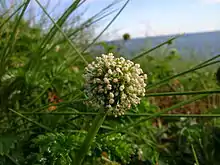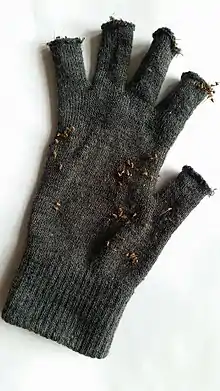Acaena novae-zelandiae
Acaena novae-zelandiae, commonly known as red bidibid,[1] bidgee widgee,[2] buzzy[3] and piri-piri bur,[4] is a small herbaceous, prostrate perennial, native to New Zealand, Australia and New Guinea,[5] of the family Rosaceae.[1]
| Red bidibid | |
|---|---|
 | |
| Scientific classification | |
| Kingdom: | Plantae |
| Clade: | Tracheophytes |
| Clade: | Angiosperms |
| Clade: | Eudicots |
| Clade: | Rosids |
| Order: | Rosales |
| Family: | Rosaceae |
| Genus: | Acaena |
| Species: | A. novae-zelandiae |
| Binomial name | |
| Acaena novae-zelandiae | |
Description
Acaena novae-zelandiae is a small herbaceous perennial. It is stoloniferous with prostrate stems of 1.5 – 2 mm diameter.[5] Damage to stolons encourages new shoots to be produced.[6]

It has imparipinnate leaves, with 9–15 toothed, oblong leaflets, which are approximately 2 –11 cm long.[5] The adaxial surface of the leaves is dark green and shiny, and the abaxial surface is hairy and glaucous green in colouration.[2][5][7] The rachis of the leaves is often red.[5]
The scape is 10 – 15 cm long[5] and bears a globular, terminal inflorescence, of 20 – 25 mm diameter,[2] with 70 – 100 flowers.[5][7] The flowers lack petals and can range in colour from green to white or purple.[8] The flowers are wind pollinated.[6]

Each flower produces one achene, bearing four approximately 10 mm long spines,[2] tipped with barbs,[2][5][7] which aid dispersal by attaching to wool, feathers and various clothing materials.[9] When the fruit are ripe, these spines are red in colouration, later becoming brown.
Taxonomy and naming
Acaena novae-zelandiae was first formally described in 1871 by Thomas Kirk who published the description in Transactions and Proceedings of the New Zealand Institute.[10][11] The genus name (Acaena) is derived from the Ancient Greek word akaina meaning "thorn" or "spine",[12] referring to the spiny calyx of many species of Acaena. The specific epithet (novae-zelandiae) refers to New Zealand.[1]
Distribution and habitat
Red bidibid is native to New Zealand, Australia and New Guinea. It has also become naturalised in California, Great Britain and Ireland.[5] It is regarded as invasive in Great Britain where it has established itself in places such as dune habitats on Lindisfarne.[13][14]
It occurs within a wide range of habitats, including woodlands, shrublands and grasslands, from coastal areas to alpine areas.[2][7] It grows in freely draining soils such as silty and sandy loams, typically on sites which receive a high amount of sunlight.[7]
It also establishes readily on disturbed sites such as roadsides.[9]
Uses
Acaena novae-zelandiae may be used for ground cover in gardens or as a lawn substitute. This plant can be prevented from spreading by limiting disturbance to stolons, thus reducing vegetative propagation,[6] and by mowing flowers before the burrs form.[15]
It has also been suggested that dried "tiny tips"[16] of young succulent leaves may be brewed as tea.[15][16][17][18]
References
- "Acaena novae-zelandiae". New Zealand Plant Conservation Network. Retrieved 12 August 2018.
- Australia, Victorian Resources Online, Agriculture Victoria. "Bidgee-widgee". vro.agriculture.vic.gov.au. Retrieved 12 March 2018.
{{cite web}}: CS1 maint: multiple names: authors list (link) - "View By Common Name | Tamar Valley Weed Strategy". weeds.asn.au. Retrieved 12 March 2018.
- "Pirri-pirri-bur". IWSL. Retrieved 12 March 2018.
- Webb, C; Sykes, W; Garnock-Jones, P; Given, D (1988). Flora of New Zealand : Volume IV, Naturalised Pteridophytes, Gymnosperms, Dicotyledons. Christchurch, NZ: Botany Division, D.S.I.R. p. 1062.
- Agriculture, California Department of Food and. "CDFA > PLANT > INTEGRATED PEST CONTROL > Encycloweedia > Noxious Weed Photographic Gallery > Acaena genus". cdfa.ca.gov. Archived from the original on 19 December 2017. Retrieved 12 March 2018.
- Gynn, E; Richards, A (1985). "Acaena Novae-Zelandiae T. Kirk". Journal of Ecology. 73 (3): 1055–1063. doi:10.2307/2260167. JSTOR 2260167.
- "Bidgee-widgee". Grains Research and Development Corporation. Archived from the original on 30 June 2018. Retrieved 12 March 2018.
- Mount, A; Pickering, C (2009). "Testing the capacity of clothing to act as a vector for non-native seed in protected areas". Journal of Environmental Management. 91 (1): 168–179. doi:10.1016/j.jenvman.2009.08.002. hdl:10072/29656. PMID 19717222.
- "Acaena novae-zelandiae". APNI. Retrieved 12 August 2018.
- Kirk, Thomas (1871). "Descriptions of new plants". Transactions and Proceedings of the New Zealand Institute. 3: 177–178. Retrieved 12 August 2018.
- Brown, Roland Wilbur (1956). The Composition of Scientific Words. Washington, D.C.: Smithsonian Institution Press. p. 796.
- "Pirri-pirri-bur". Plant Life. Retrieved 12 August 2018.
- "Pirri-pirri burr (Acaena novae-zelandiae)". GB non-native secretariat. Retrieved 12 August 2018.
- "Bidgee-widgee – Victorian Native Seed". Victorian Native Seed. Retrieved 12 March 2018.
- "Plants for the water friendly garden" (PDF). City of Clarence. Archived from the original (PDF) on 12 March 2018. Retrieved 12 March 2018.
- "Plants of Tasmania Nursery & Gardens". potn.com.au. Retrieved 12 March 2018.
- Hopkins, Kat; Alexander, Mark. "Edible Native Plants of Tasmania" (PDF).